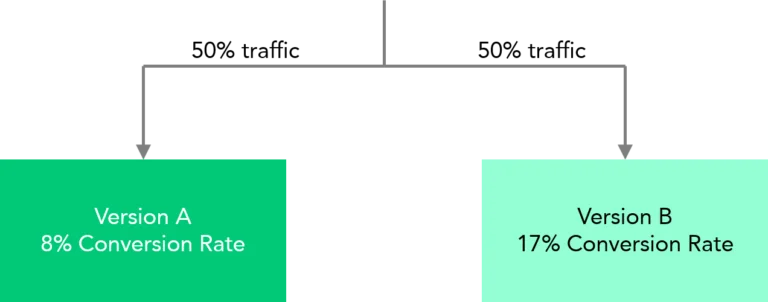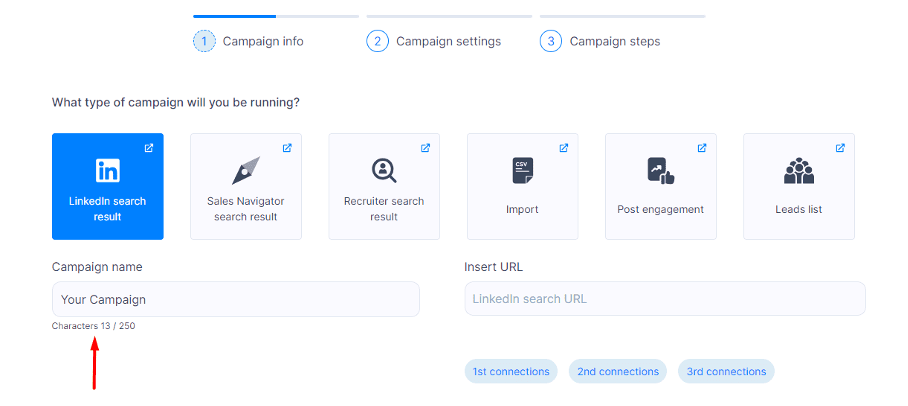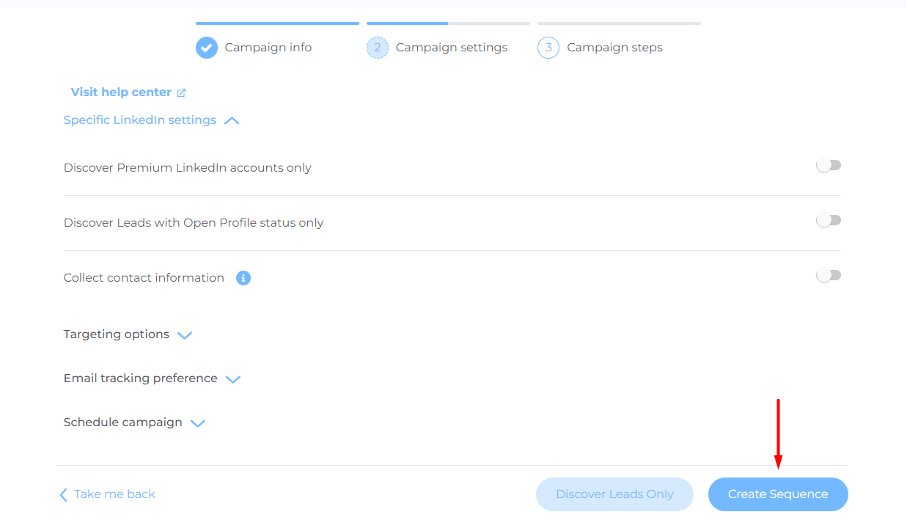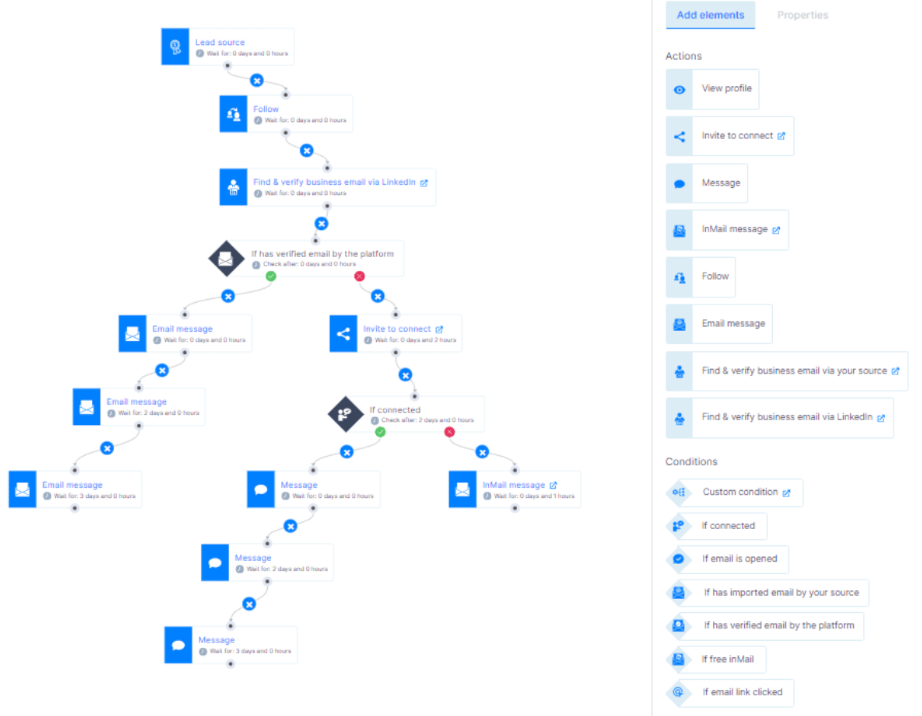6-Step A/B Testing Guide to Book More Business Calls
Do you want to know what people think of your sales efforts? Why not put them to the test? Or better yet, do some split testing!
We all know that in sales, results are essential. When creating emails, call-to-action messages, or sales email subject lines, it’s the right combination of words that will determine your final results. But how do you know what your audience finds most appealing?
Split testing, or A/B testing, is the solution!
We have been working in sales for over five years and have performed A/B tests more often than we can count or remember. This experience led to knowledge, and that’s why we present to you a guide on split testing that will help you get the desired results and make informed decisions about your next business action. If not done correctly, A/B testing (or split testing) can yield misleading results. So, if you feel stuck in the A/B testing puzzle while working in sales, you will find the following in this article:
- The benefits of split testing
- How to conduct split tests?
- What should be tested separately?
- Split testing process
- Best practices for split testing.
Let’s go!
What is A/B testing in sales?
By definition, split testing, commonly referred to as A/B testing, is a method of simultaneously sending different content versions to a shared audience to identify the most effective version that elicits the desired actions.
This approach is crucial for tasks such as writing sales copy, sending LinkedIn connection invites, testing follow-up strategies, and more, as it helps make data-driven decisions while saving money, time, and potential leads.
In sales, split testing compares two versions of a sales pitch to determine which yields the most results, thus increasing conversions and sales outcomes. In prospecting, you can test your approach across all communication channels. Additionally, you can even test different elements to determine the most effective approach for lead generation and prospecting.
Why should you do A/B testing?
- Split testing is a straightforward analysis.
One of the most interesting aspects of split testing is its simplicity. It’s easy and straightforward, and if done correctly, an A/B test can significantly improve your sales efforts. Moreover, using the right tool can help save time by partially automating the process for even better results, but we’ll get back to that later in this blog.
- A/B tests are multifunctional.
Almost anything can be A/B tested. For example, in Leadin, our LinkedIn automation tool and cold email sending software, you can test up to five variations of:
- LinkedIn connection messages
- InMails
- Emails
- Messages
Furthermore, you can test smaller factors in these messages, such as message text, subject lines, message body, signature, links, or calls to action.
Note: From our experience, we advise you not to test everything at once. Why? Because you won’t be able to determine what influenced the results. It is better to test one element at a time. Additionally, ensure to constantly refine and retest options that have performed well.- You can increase conversion rates.
By performing A/B tests on different elements of a campaign or website, salespeople can see what works best when the goal is to convert leads into clients. By testing several approaches and choosing the most effective one, higher conversion rates and a better lead generation strategy are achieved.


- You can make data-driven decisions.
Why wonder and guess when you can be sure of what you know? Split testing provides the kind of data-driven certainty that helps you make informed decisions, because numbers don’t lie.
- Your potential customers will benefit from a better user experience.
If we use split-test data to better understand our target audience, you can easily give your potential customers what they want, strengthening relationships and making their experience more user-friendly and enjoyable. A/B testing ultimately helps to build customer loyalty, strengthen your brand’s reputation and attract more customers.
- It’s profitable.
In sales, optimization is paramount, and split testing is a very cost-effective way to gather more useful data about your sales or marketing approach. The calculation is simple: you can use A/B testing to determine whether or not the changes are right for you, before making larger investments. In the long term, split testing saves a great deal of time and money.
Now that you know why you should do split testing, here’s a list of things you can test. 👇
What can you A/B test?
In sales, there are many ways to optimize performance and increase conversions. Here is the complete list:
- Sending e-mails (subject line, body text, CTA)
- LinkedIn prospecting (connection request, LinkedIn message, InMail – subject, message, personalization)
- Pricing strategies (different pricing models or discount offers)
- Product presentations and demonstrations (presentation style, product demonstration tactics)
- Value propositions (different formulations, product presentation, service value propositions)
- Bundles (combinations of product or service bundles)
- Social proof and testimonials
- Up-selling and cross-selling techniques
How to carry out A/B tests
Split testing sounds good now, doesn’t it? Want to use it right away? Here’s how to do it, step by step 👇
A/B testing – 6 general steps
- Identify objectives
Conversion targets are the most important measure to take into account when planning a split test. They should be sufficient to help you determine whether the variant (or option B) is better than the original. These objectives can be link clicks, call bookings or product purchases.
- Gathering data
Some prospecting tools often provide an overview of the areas you can and should optimize. This enables you to collect data more quickly and identify areas for improvement.
- Determine which part of the prospecting process you wish to A/B test
By examining the indicators, you can easily find parts of your sales process that should be A/B tested. For example, a poor open rate often leads to a poor response rate. A poor open rate often implies a poorly-written subject line. To start, choose an indicator, find something that causes it and test it.
- Create test variants
With split testing, you can use specialized software to make the desired changes to any element you wish to test. This could mean creating a different version of your LinkedIn invitation to connect message, a different email subject line or something else entirely.
- Divide your sample audience
Once you’ve created one or more test variants, you need to split the audience sample in two (or more, if there are more variants) and decide who will see variant A and who will see variant B (or more) of your split-test experiment. Some tools, like Leadin, usually do this for you randomly and evenly to ensure a fair comparison result.
- Execute, analyze and optimize
Once you’ve launched the split test, all you have to do is track and measure the results of each version you’ve created. You can, of course, use tools to track conversion rates and overall engagement indicators, for further study and optimization.
The final step in split testing is to analyze the results of your experiment. Now all you have to do is decide which version to adopt. Nothing could be simpler.
How do you test the different parts of the sales process?
Salespeople involved in prospecting use A/B testing to determine whether their prospecting efforts are recognized by prospects or not. You can use these tests for several parts of your sales process. These can include testing sales emails and subject lines, product presentations and demos, follow-up strategies and customer segmentation. Let’s take a look at some of these in detail. 👇
A/B prospecting tests
Email prospecting
These days, prospecting has mainly shifted to digital. If we use the e-mail as a starting point for split testing, we can test several elements of our cold e-mail. For example, if prospecting isn’t yielding enough results, such as opening rates, we should use split testing to try out different variants of our subject line. If the number of clicks on the links is insufficient, we should consider testing the CTA that leads to that link, or the body of the e-mail, and so on.
To summarize, in the context of e-mail prospecting, we can test 👇
- Subject lines – Creating a catchy subject line is what makes or breaks your open rates. A/B testing is the ideal way to determine what works and what doesn’t for your sample audience. When testing subject lines, make sure you test only that and no other element. Leadin lets you test up to 5 different variants at a time.
- The body of the e-mail – If your subject line attracts attention, but people aren’t really responding to your e-mail the way you want them to, the element you should test fractionally is the body of the e-mail. Use the same subject line and CTA, but modify the content and determine the tone that best suits your target group. You can experiment with different lengths, the use of emojis, writing styles and more.
- CTA – Your audience responds to clear instructions. The call to action must therefore be the last thing they read and the first thing they do. If you think the call to action is the problem with your sales emails, you should write a few variations and test just the call to action element to find out what works best for your niche audience.
- Personalization (images and GIFs) – These days, people don’t just focus on text. But if you add visual elements, it’s a different story. In fact, we’ve tested it extensively and learned that adding personalized images, GIFs and even videos to your e-mail prospecting campaign can increase response rates significantly – by up to 63%! If you know this element works well in cold prospecting, you should run A/B tests to determine what works best for each audience segment.
Prospecting on LinkedIn
In recent years, sales prospecting has gone digital, and what better place to find potential prospects than LinkedIn – a professional social media platform with nearly a billion users and 63 million decision-makers? If you narrow your audience down to a smaller sample, you can use split testing to determine which social selling techniques work best for your LinkedIn prospecting efforts.
With the help of an automation tool, you can make the A/B testing process much easier. What’s more, if the tool has excellent statistics tracking, your analysis and final decision will be clear. And now, here are all the things you can split-test when it comes to LinkedIn. 👇
- Connection requests – This is your opening on LinkedIn, and it needs to be short enough to keep their attention, but also important enough to inspire an immediate response. It can be difficult to find the right note, especially with a cold approach. This is where split tests come in handy, as they make it easy to determine your opening approach. You can try sending blank, personalized or generic invitations to connect. You can even try out contact templates if you’re new to A/B testing, and use them as a starting point.
- LinkedIn messages – Once you’ve established a connection with your prospect, your follow-up message on LinkedIn needs to keep their attention throughout the conversation and inspire them to take action. It could be an appointment, a demonstration, a call or a click on a link. Experiment with tone, length and emojis; again, make sure you don’t change everything at once.
- InMails – When it comes to people who seem out of your reach on LinkedIn (i.e. not a second or third connection), InMail messages are there to help make that connection. Being off the grid doesn’t mean being out of range. But certainly, if a complete stranger approaches you or, in this case, sends you an InMail message out of the blue, you’re bound to wonder why this person is contacting me. Of course, split testing is there to help you determine which subject line or message works best for this type of connection attempt.
- Personalization – As with email, personalization on LinkedIn, where everyone is busy and inboxes are flooded with all kinds of requests (especially in the case of decision-makers), can set you apart from your competitors. Using images, GIFs and videos can help turn prospects into customers in no time! We know – we did the tests ourselves! Here again, you can use Leadin to test which visual elements make your target audience more receptive to your sales pitch.
Now that you know where and what to test, the question is which tool to use. We’ve been hinting at it all along, but yes, you can use Leadin, a LinkedIn automation and cold email software that offers A/B testing functionality. You can use it to test different elements, such as the logo, the company name, etc. You can use it to test different elements of your email and LinkedIn prospecting campaign.
To get started, create your prospecting campaign. 👇




2. Then select your lead source or where Leadin will pull leads from.




This is how you create your smart sequence – an algorithm that allows you to combine “if” conditions with different actions. This way, Leadin will follow the prospecting flow you create and find the fastest path to your prospect.
Here is an example of a multichannel smart sequence in Leadin 👇


Then suppose you want to perform an A/B test on your email subject lines. Click on the email message step and add two variants of the subject line with the same email message by clicking the Test B button.
You can add up to 5 variants of the subject line in Leadin:


Finally, once your campaign is completed, proceed to the reports page, scroll through the steps of your sequence, and check the results. There you have it!
Here is your winning subject line:


Here is an overview of everything you can test with Leadin. ⬇️
A/B Testing in Leadin | Results |
Subject Line (Emails and InMails) | Play with the subject line text, length, emojis, caps lock, etc. Test the subject line that affects the desired open rate. |
Images and GIFs (Emails, InMails, LinkedIn) | Modify images and GIFs, play with personalization, add or change a single personalized element, etc. Check which images and GIFs influence response/conversion rates. |
Writing Style (all formats) | Test different writing styles and tones of voice depending on your target audience to increase the response rate. |
Formatting (all formats) | Check if splitting the message body into multiple parts, with or without headings, yields the desired results. |
Call to Action – CTA (all formats) | Check which call to action generates the most conversions. |
Content Depth (all formats) | Check whether your audience prefers long content that covers every detail, or shorter content. |
Connection Invitations | Send blank connection invitations, generic or personalized messages to see what people respond to the most. |
Paragraph (all formats) | Modify the key paragraph of your message body to check your prospects’ behavior and see if you get the expected results. |
Message Body (connection invitation, LinkedIn message, InMail, email) | Send a completely different message body to see the impact on response/conversion rates. |
Delay | Check if the delay between messages affects response/conversion rates. |
Links | Insert different links and see if your prospects are interested in them. |
Signature | Insert in your signature links or other texts that might increase call and demo requests. |
Note: with Leadin, you can combine LinkedIn and email for personalized multichannel engagement.
Other prospecting elements you can test separately
- Pricing Strategies
You can use A/B testing to determine the pricing model that best suits your target audience. You can even go further and experiment with discount offers to determine what generates the most sales and revenue.
- Product Presentations and Demonstrations
In sales research, you should always change the style or content of your product demonstrations. You can use split tests to find the most compelling way to present your product’s value to prospects, which will ultimately lead to more conversions and better overall results.
- Value Propositions
You can easily see how your target audience reacts to different formulations and presentations of products or service value propositions. Just divide them into two groups and start A/B testing!
Note: Leadin automatically separates your prospects according to the number of A/B tests created. If you do, for example, 3 split tests, then 1/3 of the prospects will automatically go to each variant. This way you don’t have to separate your prospects yourself and send them manually.
- Offer Bundling
Sometimes, offering the right combination of products or services can turn a potential prospect into a satisfied customer. The right bundled offer can have a significant impact on sales and increase them.
- Social Proof and Testimonials
You can use A/B testing to see how changing the presentation of customer testimonials influences trust and your prospects’ purchasing decisions.
- Upselling and Cross-Selling Techniques
You can use A/B split testing to experiment with different upselling or cross-selling methods. There may be a better offer to make to your potential customers that will make them more receptive to your sales pitch.
6 Best Practices for Split Testing
Before letting you test your sales efforts, we must highlight some best practices that we have deeply experimented with in A/B testing and our own sales actions. ⏬
- Test one element at a time
We already said it and we repeat it. Testing too many elements at once will give misleading results. If, for example, you change the CTA and email body simultaneously, you won’t get clear results on which change your audience reacted to. Start with the weakest part of your approach.
By testing one element at a time, you will obtain reliable results. Furthermore, there is no rush. Once you start optimizing your site, you will make significant changes by doing one A/B test at a time, and the results will be inevitable.
Note: Test both variants (or more) simultaneously.
- Determine the test duration
Many sellers make the mistake of not allowing enough time for a split test to produce valid results. So don’t forget to give the A/B test enough time to produce useful and valid data. Generally, allow between 2 and 6 weeks depending on your sales cycle and industry.
- Test the timing
Not testing different timings between messages can skew your data. Create different scenarios and timings, as they can have a considerable impact on response and conversion rates.
- Get feedback from real users
Split tests generate a lot of useful data, but they don’t say why certain actions are undertaken. Complement your tests with surveys or polls to better understand your audience.
- Use tools to test and analyze your data
A/B testing should be conducted with suitable tools. Solutions like Leadin automate the process and provide you with precise analytics to make real-time data-driven decisions.
- Test and optimize frequently
Consider split testing as an ongoing process. Do it often and do it well. In sales, constant improvement is essential to achieve better results.
6 Split Testing Errors
Not focusing on the “right problem to test”
You can test nearly every element of your business approach, but if you don’t focus in the right place, you will waste time and resources. Analyze your indicators (open, response, bounce rates, etc.) to identify the real source of the problem.
Testing without a hypothesis
Testing random elements will only waste your time. Each test should have a clear intention and objective. Here is how to formulate a solid hypothesis:
- Identify the problem – Determine what is holding back (e.g., subject line, CTA).
- Propose a solution – Imagine what could fix the problem and test several variants.
- Create the hypothesis – Formalize what you will test and what you expect from the result.
Stopping the split test too early
If you get impatient and stop a test too early, you risk obtaining results skewed by temporary fluctuations. But be careful not to prolong it too long either: external factors like seasons or market trends can skew your results. Find the right duration.
Executing complex tests
By “complex,” we mean tests without a clear intention that modify several elements at once. For example, if your emails are opened but not replied to, first test the CTA or message body, but not both at the same time. Keep your tests simple to get actionable results.
Not considering external factors
Many things can influence your prospects: holidays, the market, trends, competition… Always take them into account to avoid drawing incorrect conclusions.


Ignore the results
In some cases, it won’t be easy to believe the A/B test results. But why? Sometimes, the clear results of A/B testing do not align with the marketers’ expectations. This is where you need to set aside your ego and beliefs and trust the data. If your split test was conducted properly, there’s no need to ignore the results. This would only harm you and your business.
Ready to put your lead generation efforts to the test?
As we have seen, A/B testing is a powerful tool that, when used correctly, can significantly improve your lead generation results. You can easily find the weak link in your prospecting through analysis and use split testing to determine what works best to continuously optimize your approach to achieve solid results every time. 🔎
Let’s recap the benefits of conducting A/B tests:
- Increase open and response rates (for email and LinkedIn)
- Improve email copy (writing style, tone, emojis, length)
- Reduce bounce rates (for email account health)
- Increase conversion rates
- Get fast results (optimize quickly and often)
- Reduce risks (well-informed decisions)
- Increase sales (via email and LinkedIn)
If you regularly prospect, then automating the process is a necessity. This is when you’ll need to use the right tools. Let Leadin assist you in optimizing your contacts. You can sign up for a 14-day free trial and discover all the benefits of LinkedIn and email automation with our A/B testing option.
Launch your first lead generation campaign today!
